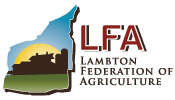 March 21, 2016
March 21, 2016
Dave Posliff, Manager
789 Broadway Street, Box 3000
Wyoming, ON N0N 1T0
Cc: David Cribbs
The Lambton Federation of Agriculture (LFA) is pleased to have the opportunity to comment on the proposed draft Lambton Shores Official Plan. The LFA is committed to supporting farm businesses to help form the backbone of a robust food system that drives the local economy forward. Because of our commitment to ensuring residence have access to safe, nutritious, high quality food through the responsible use of our resources, and the support of our government, we continue to have some alarming concerns with the Lambton Shores Council adopted document, that we do not support as an organization. Because Agriculture is one of the largest industries driving the local economy we stress the importance of including an agricultural perspective within the Lambton Shores Official Plan.
Within this letter are some main concerns for the Draft 7 Official Plan to include policies that improve the effectiveness of protecting our natural resources as well as our agricultural resources.
Section 3.5.2 (Table 3), Environmental Impact Studies (EIS)
There are concerns with the language used in Table 3 (Ecological Buffer Zones and Areas Subject to an Environmental Impact Study). The Ministry of Natural Resources and Forestry (MNRF) Natural Heritage Manual uses the term “Adjacent Lands” as opposed to buffers, which is used in Table 3. We would suggest using “Adjacent Land” as oppose to “Minimum Buffer Width” as terminology to remain consistent with the most updated manual. This terminology is also better accepted and understood as an area potentially subject to EIS.
Section 3.9, Page 66; Drainage
The Drain Primer (2008) document referenced as a principle guideline in the Official Plan is out dated. There is a Drainage Act and Conservation Authorities Act Protocol document that may be a better reference for finding ways to maintain the effectiveness of municipal drains while limiting impacts on the natural environment. We would encourage that this document be considered with the Drainage Act as well to ensure that drains are also functional and a viable outlet for land-owners, including those with systematic tiling.
Section 4, Page 78; Buffer Widths
This table remains very troubling to our industry and, if implemented, could act as a dangerous precedent. The buffer widths are highly excessive, and there fails to be any definitive science that supports any of these recommended buffer widths. The Ministry of Natural Resources Natural Heritage Reference Manual speaks about limits of “adjacent areas” to key natural heritage features; these guidelines include similar setbacks from development sites. We cannot confuse development sites with productive agricultural land. If adapting policy from the manual it is essential to ensure that our key natural heritage features and limitations protect ecological functions without severely depleting productive agricultural land. The interpretation of this chart could lead to the enforcement of these buffer widths, the inclusion of this chart is ill-advised and a serious potential threat to the industry and producers
If planners decide to enforce this it will overlook PPS Policy 2.1.9; “Nothing in policy 2.1 [Natural Heritage] is intended to limit the ability of agricultural uses to continue.” This would include the drastic limitations set out in this table that could ultimately put acres of land out of production.
Also, buffer widths for the habitat of endangered or threatened species (key natural heritage features) are governed under the Endangered Species Act, 2007 and by accompanying regulations. This includes O. Reg. 242/08, which references habitat regulation for invasive species using a definitive science approach. The Official Plan does not need to further regulate or recommend what is being managed at the Provincial level, especially without referencing reliable sources to support the recommendations. The Official Plan can reference the Invasive Species Act and/or the Conservation Authority Act(s) directly if they wish to provide recommendation of proper land-uses surrounding natural heritage features.
Finally, the “exception” to the policies in an Environmental Farm Plan (EFP) is in place is unacceptable. EFPs are confidential and cannot be a requirement to be approved for an exception for any limitation within an Official Plan. Environmental Farm Plans do not exist to provide these exceptions, whether it is a recommendation or not. Since the Environmental Farm Plan cannot be accessed at the level of government who wishes to make this recommendation, the chart shows no significance and only acts as a dangerous precedence if interpreted in such a way that could be detrimental to the Agricultural industry.
For these reasons we would highly recommend removing this chart from the Draft Official Plan. The Municipality may still choose to reference regulations from other governing bodies to help encourage the protection of Natural Heritage Features, which ultimately addresses the concern more responsibly than the current chart found in the Plan.
Agriculture remains a large and significant industry within the municipality. We would appreciate that the above concerns are adapted and the Draft 7 Official Plan be amended before approval. These efforts would recognize the importance of agriculture in our community and economy and be a great strive towards adapting policy to protect and promote it.
I trust that our opinions will be given due consideration.
Sincerely,
~Dave Ferguson~
President, Lambton Federation of Agriculture
